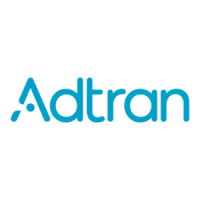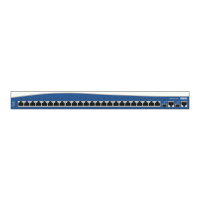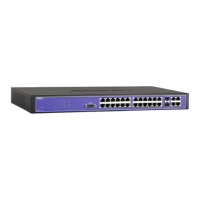617004660F1-13F 32 617004660F1-13F
The NetVanta 4660 unit’s IP address can be configured from either the Gigabit Ethernet
subinterface (for a user network interface (UNI)) or the system management Ethernet virtual
connection (EVC) (for a network-to-network interface (NNI)).The following steps assign an
IP address and subnet mask for the GIG 0/2.1 Gigabit Ethernet subinterface.
1. At the # prompt, enter config terminal.
2. At the (config)# prompt, enter interface gig 0/2.1 to access the configuration
parameters for the Gigabit Ethernet subinterface.
3. Enter ip address
192.168.1.1 255.255.255.0 to assign an IP address to the Ethernet
subinterface using a 24-bit subnet mask.
4. Enter exit to exit the Gigabit Ethernet subinterface commands and return to the
Global Configuration mode.
5. Enter ip route
0.0.0.0 0.0.0.0 192.168.1.254 to add a default route to the route table.
0.0.0.0 is the default route and the default subnet mask, and 192.168.1.254 is the
next-hop IP address to which the AOS unit should send all of its traffic. You will need
to enter the proper route, subnet mask, and gateway for your network. This
information is typically provided by an Internet service provider (ISP) or local network
administrator.
6. Enter do write memory to save the current configuration.
ENABLE TELNET USER LOGIN ACCESS
The following steps create a password of adtran for Telnet access. By default, Telnet
access is enabled with a password of password.
1. Verify that the prompt of your unit displays (config)#.
2. Enter line telnet 0 4 to change the configuration parameters for the Telnet sessions.
3. Enter login to require a password for Telnet access.
4. Enter password
adtran to change the login password for the Telnet sessions.
5. Enter exit to return to the Global Configuration mode.
6. Verify that the prompt of your unit displays (config)#.
7. Enter do write memory to save the current configuration.
NETVANTA 4660 DEFAULTS
Feature Default Value
User Name admin
Password password
Enable Password password
HTTP Server Disabled
Event History Enabled
IP Routing Enabled
DHCP Client Enabled
Auto-Config Zero Touch Provisioning Enabled
3. Provide power to the unit as appropriate. Refer to the NetVanta 4660/5660 Hardware
Installation Guide at
https://supportforums.adtran.com for more details.
4. Once the unit is powered up, open a VT100 terminal session using the following
settings: 9600 baud, 8 data bits, no parity bits, and 1 stop bit. Press <Enter> to
activate the AOS CLI.
5. Enter enable at the > prompt. Enter the enable password when prompted. The default
password is password.
You can also access the CLI from a Telnet or SSH client. In order to do this, you must know
the IP address of the AOS device. If you do not know the unit’s IP address, you must use
the CONSOLE port to access the CLI. To access the CLI using a Telnet or SSH client,
follow these steps:
1. Connect the NetVanta unit to your PC using an Ethernet cable connected to the
GIG 0/2 Gigabit Ethernet port on the front of the device or connect the NetVanta unit
to an existing network that supports DHCP using the GIG 0/2 Gigabit Ethernet port on
the front of the device.
2. Open a Telnet or SSH client on your computer and enter 10.10.10.1. If your unit
received an IP address from a DHCP server or you have changed your unit’s IP
address, you will need to enter that address.
3. For SSH, log into the unit using the default login (admin) and password (password).
For Telnet, only the default password (password) is required.
4. Enter enable at the > prompt and enter the enable password when prompted. The
default password is password.
COMMON CLI COMMANDS
The following are common CLI commands and tips for getting started with the CLI.
■
Entering a question mark (?) shows contextual help and options. For example,
entering ? at the prompt will show all commands available from that prompt.
■ To view interface statistics, enter show interfaces <interface type> <interface
number>.
■ To view the current configuration, enter show running-config.
■ To view all the IP addresses currently configured, enter show ip interfaces brief.
■ To view the AOS version, serial number, and other information, enter show
version.
■ To view the routing table, enter show ip route.
■ To save the current configuration, enter write.
MANUALLY CONFIGURING THE UNIT’S IP ADDRESS
g NOTE
The configuration parameters used in the examples outlined in this document are for
instructional purposes only. Please replace all underlined entries (
example) with your
specific parameters to configure your application.This step is unnecessary if the unit’s IP
address has been configured automatically using DHCP.
